Nuffield Trust: Unit 33 Report on Supporting Medication in Social Care
VerifiedAdded on 2020/07/22
|8
|2091
|45
Report
AI Summary
This report analyzes the critical aspects of medication support within a social care setting, using Nuffield Trust as a case study. It begins by outlining the relevant policies and legislations, including the Medicines Act 1968 and the Health Act 2006, and their impact on medication practices. The report then details the roles and responsibilities of various staff members, such as care workers, managers, nurses, and pharmacists, in medication management. It explains how medication details are accessed through documents like MAR reports and care plans, and describes different routes of administration (oral, inhalation, injection, etc.) and forms of medication (solid, liquid, gas, etc.). Furthermore, the report highlights the use of equipment like spacer devices, oral syringes, and nebulizers to aid in medication delivery. It also explains how data on medication usage is recorded, emphasizing the importance of MAR sheets and care records. Finally, the report discusses the safe storage and disposal of medications, adhering to guidelines like COSHH and hazardous waste regulations, to ensure patient safety and regulatory compliance.
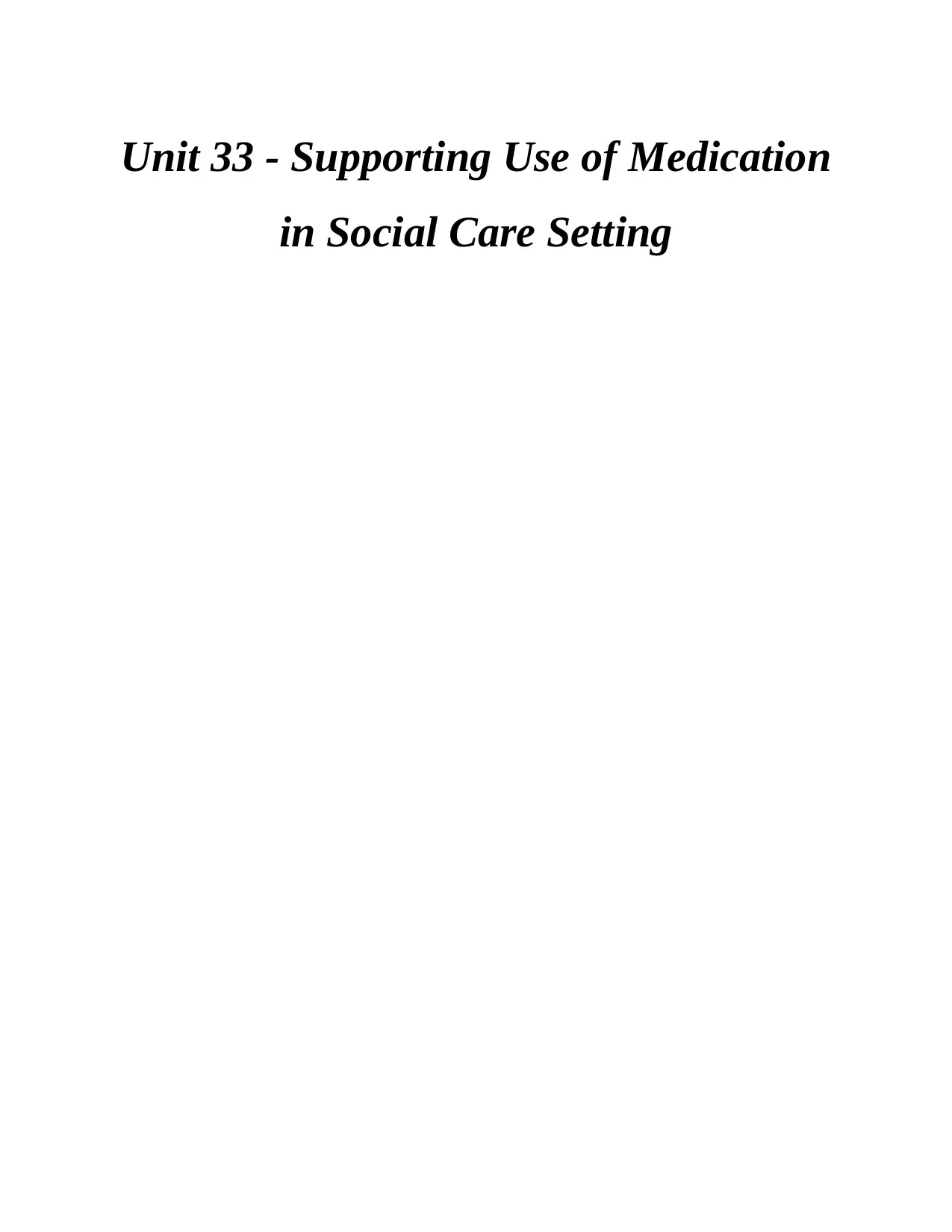
Unit 33 - Supporting Use of Medication
in Social Care Setting
in Social Care Setting
Paraphrase This Document
Need a fresh take? Get an instant paraphrase of this document with our AI Paraphraser
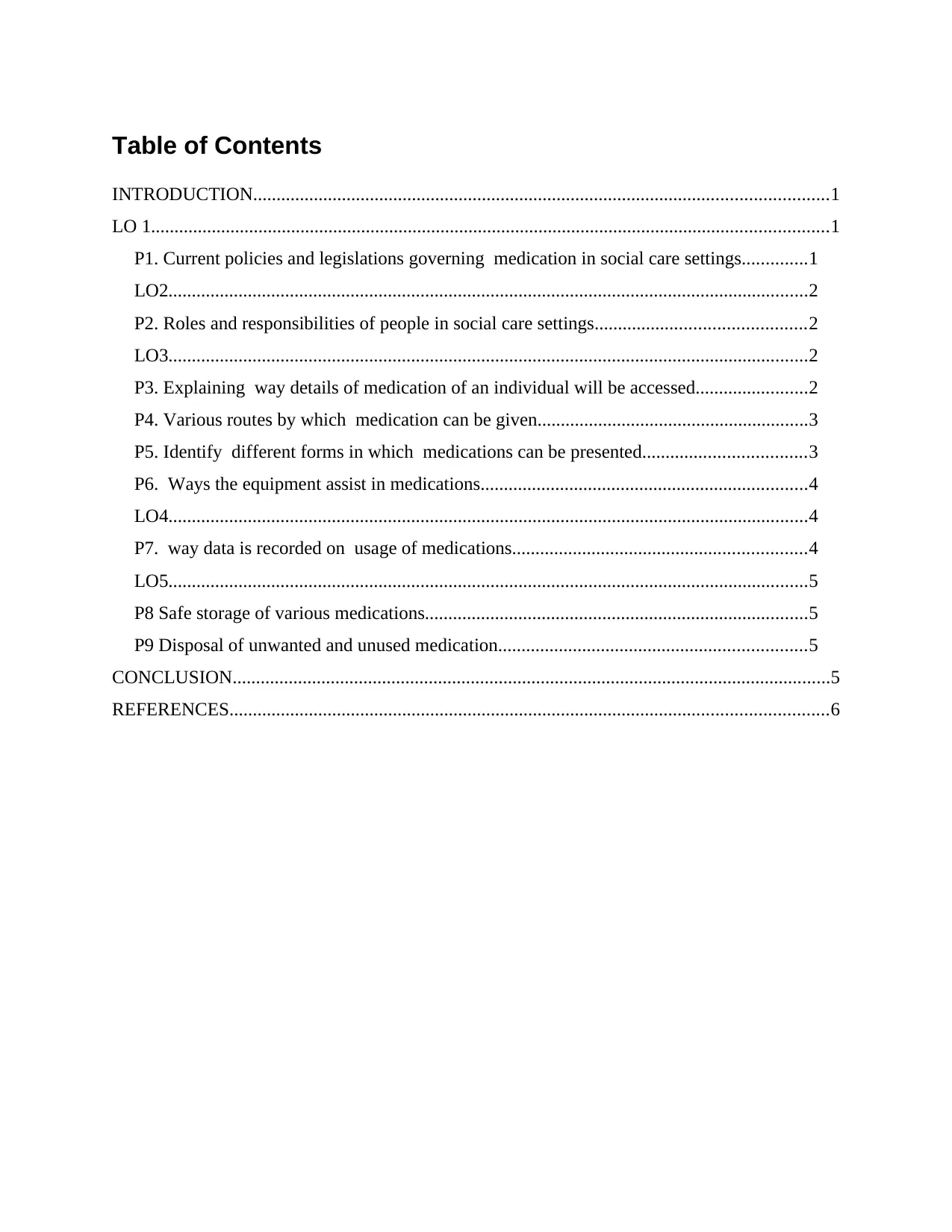
Table of Contents
INTRODUCTION...........................................................................................................................1
LO 1.................................................................................................................................................1
P1. Current policies and legislations governing medication in social care settings..............1
LO2.........................................................................................................................................2
P2. Roles and responsibilities of people in social care settings.............................................2
LO3.........................................................................................................................................2
P3. Explaining way details of medication of an individual will be accessed........................2
P4. Various routes by which medication can be given..........................................................3
P5. Identify different forms in which medications can be presented...................................3
P6. Ways the equipment assist in medications......................................................................4
LO4.........................................................................................................................................4
P7. way data is recorded on usage of medications...............................................................4
LO5.........................................................................................................................................5
P8 Safe storage of various medications..................................................................................5
P9 Disposal of unwanted and unused medication..................................................................5
CONCLUSION................................................................................................................................5
REFERENCES................................................................................................................................6
INTRODUCTION...........................................................................................................................1
LO 1.................................................................................................................................................1
P1. Current policies and legislations governing medication in social care settings..............1
LO2.........................................................................................................................................2
P2. Roles and responsibilities of people in social care settings.............................................2
LO3.........................................................................................................................................2
P3. Explaining way details of medication of an individual will be accessed........................2
P4. Various routes by which medication can be given..........................................................3
P5. Identify different forms in which medications can be presented...................................3
P6. Ways the equipment assist in medications......................................................................4
LO4.........................................................................................................................................4
P7. way data is recorded on usage of medications...............................................................4
LO5.........................................................................................................................................5
P8 Safe storage of various medications..................................................................................5
P9 Disposal of unwanted and unused medication..................................................................5
CONCLUSION................................................................................................................................5
REFERENCES................................................................................................................................6
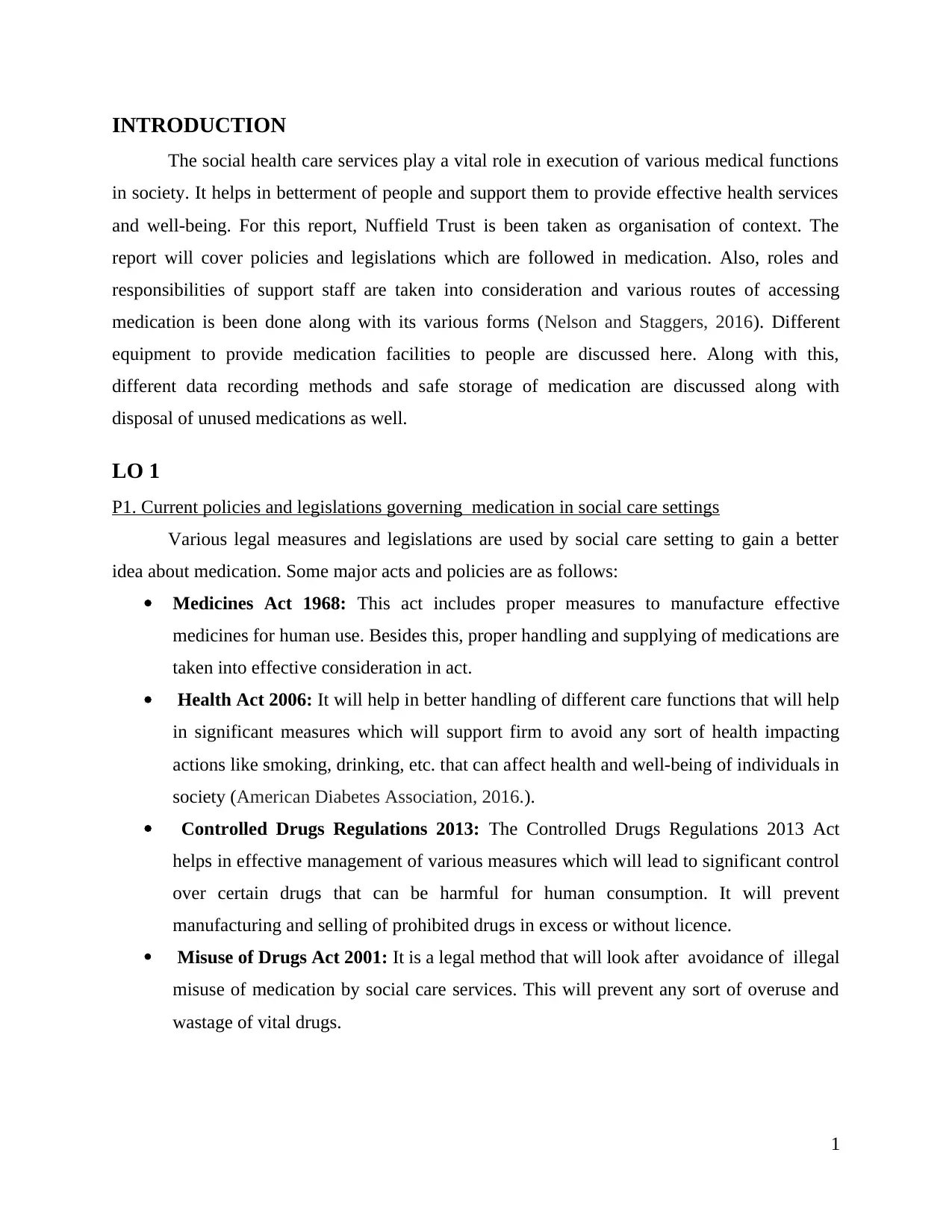
INTRODUCTION
The social health care services play a vital role in execution of various medical functions
in society. It helps in betterment of people and support them to provide effective health services
and well-being. For this report, Nuffield Trust is been taken as organisation of context. The
report will cover policies and legislations which are followed in medication. Also, roles and
responsibilities of support staff are taken into consideration and various routes of accessing
medication is been done along with its various forms (Nelson and Staggers, 2016). Different
equipment to provide medication facilities to people are discussed here. Along with this,
different data recording methods and safe storage of medication are discussed along with
disposal of unused medications as well.
LO 1
P1. Current policies and legislations governing medication in social care settings
Various legal measures and legislations are used by social care setting to gain a better
idea about medication. Some major acts and policies are as follows:
Medicines Act 1968: This act includes proper measures to manufacture effective
medicines for human use. Besides this, proper handling and supplying of medications are
taken into effective consideration in act.
Health Act 2006: It will help in better handling of different care functions that will help
in significant measures which will support firm to avoid any sort of health impacting
actions like smoking, drinking, etc. that can affect health and well-being of individuals in
society (American Diabetes Association, 2016.).
Controlled Drugs Regulations 2013: The Controlled Drugs Regulations 2013 Act
helps in effective management of various measures which will lead to significant control
over certain drugs that can be harmful for human consumption. It will prevent
manufacturing and selling of prohibited drugs in excess or without licence.
Misuse of Drugs Act 2001: It is a legal method that will look after avoidance of illegal
misuse of medication by social care services. This will prevent any sort of overuse and
wastage of vital drugs.
1
The social health care services play a vital role in execution of various medical functions
in society. It helps in betterment of people and support them to provide effective health services
and well-being. For this report, Nuffield Trust is been taken as organisation of context. The
report will cover policies and legislations which are followed in medication. Also, roles and
responsibilities of support staff are taken into consideration and various routes of accessing
medication is been done along with its various forms (Nelson and Staggers, 2016). Different
equipment to provide medication facilities to people are discussed here. Along with this,
different data recording methods and safe storage of medication are discussed along with
disposal of unused medications as well.
LO 1
P1. Current policies and legislations governing medication in social care settings
Various legal measures and legislations are used by social care setting to gain a better
idea about medication. Some major acts and policies are as follows:
Medicines Act 1968: This act includes proper measures to manufacture effective
medicines for human use. Besides this, proper handling and supplying of medications are
taken into effective consideration in act.
Health Act 2006: It will help in better handling of different care functions that will help
in significant measures which will support firm to avoid any sort of health impacting
actions like smoking, drinking, etc. that can affect health and well-being of individuals in
society (American Diabetes Association, 2016.).
Controlled Drugs Regulations 2013: The Controlled Drugs Regulations 2013 Act
helps in effective management of various measures which will lead to significant control
over certain drugs that can be harmful for human consumption. It will prevent
manufacturing and selling of prohibited drugs in excess or without licence.
Misuse of Drugs Act 2001: It is a legal method that will look after avoidance of illegal
misuse of medication by social care services. This will prevent any sort of overuse and
wastage of vital drugs.
1
⊘ This is a preview!⊘
Do you want full access?
Subscribe today to unlock all pages.

Trusted by 1+ million students worldwide
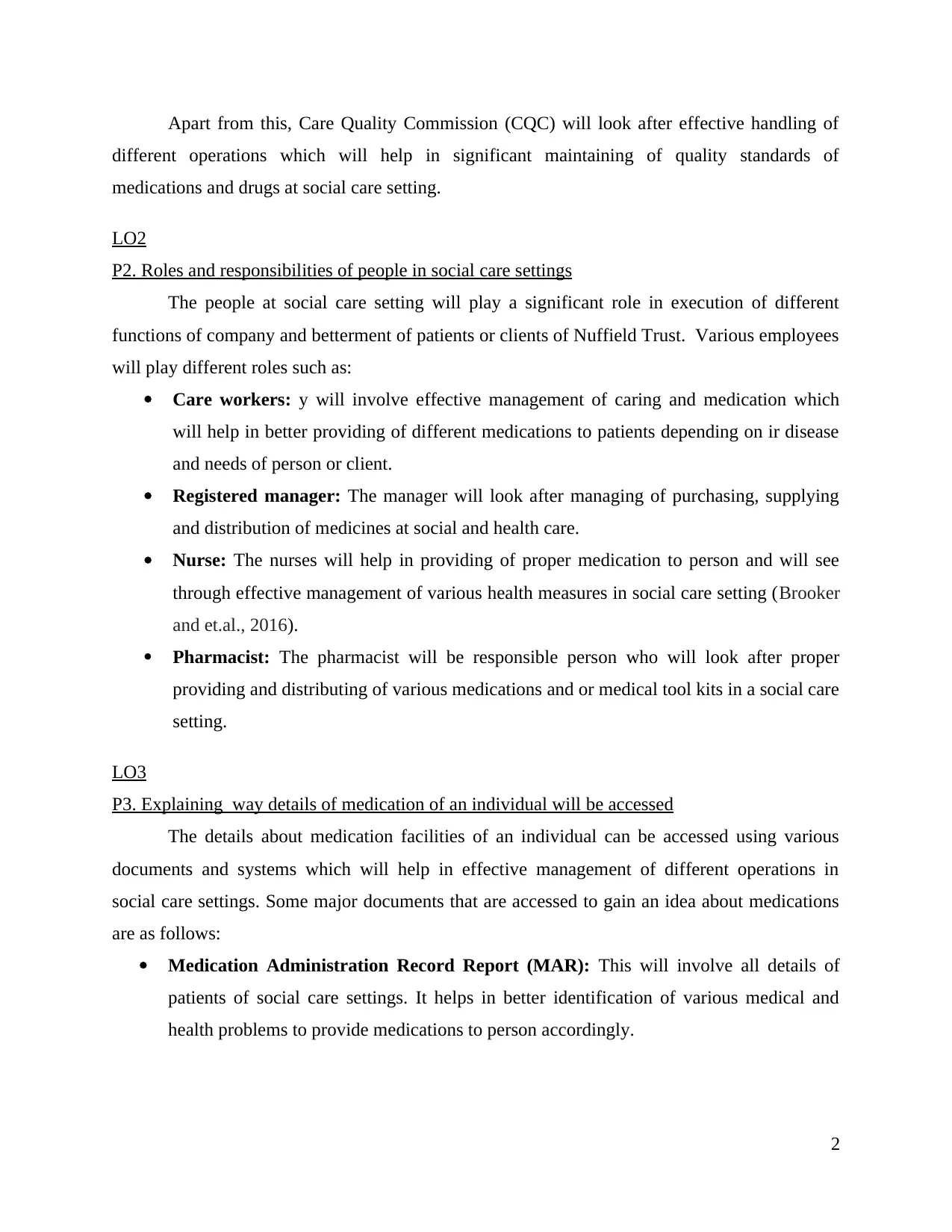
Apart from this, Care Quality Commission (CQC) will look after effective handling of
different operations which will help in significant maintaining of quality standards of
medications and drugs at social care setting.
LO2
P2. Roles and responsibilities of people in social care settings
The people at social care setting will play a significant role in execution of different
functions of company and betterment of patients or clients of Nuffield Trust. Various employees
will play different roles such as:
Care workers: y will involve effective management of caring and medication which
will help in better providing of different medications to patients depending on ir disease
and needs of person or client.
Registered manager: The manager will look after managing of purchasing, supplying
and distribution of medicines at social and health care.
Nurse: The nurses will help in providing of proper medication to person and will see
through effective management of various health measures in social care setting (Brooker
and et.al., 2016).
Pharmacist: The pharmacist will be responsible person who will look after proper
providing and distributing of various medications and or medical tool kits in a social care
setting.
LO3
P3. Explaining way details of medication of an individual will be accessed
The details about medication facilities of an individual can be accessed using various
documents and systems which will help in effective management of different operations in
social care settings. Some major documents that are accessed to gain an idea about medications
are as follows:
Medication Administration Record Report (MAR): This will involve all details of
patients of social care settings. It helps in better identification of various medical and
health problems to provide medications to person accordingly.
2
different operations which will help in significant maintaining of quality standards of
medications and drugs at social care setting.
LO2
P2. Roles and responsibilities of people in social care settings
The people at social care setting will play a significant role in execution of different
functions of company and betterment of patients or clients of Nuffield Trust. Various employees
will play different roles such as:
Care workers: y will involve effective management of caring and medication which
will help in better providing of different medications to patients depending on ir disease
and needs of person or client.
Registered manager: The manager will look after managing of purchasing, supplying
and distribution of medicines at social and health care.
Nurse: The nurses will help in providing of proper medication to person and will see
through effective management of various health measures in social care setting (Brooker
and et.al., 2016).
Pharmacist: The pharmacist will be responsible person who will look after proper
providing and distributing of various medications and or medical tool kits in a social care
setting.
LO3
P3. Explaining way details of medication of an individual will be accessed
The details about medication facilities of an individual can be accessed using various
documents and systems which will help in effective management of different operations in
social care settings. Some major documents that are accessed to gain an idea about medications
are as follows:
Medication Administration Record Report (MAR): This will involve all details of
patients of social care settings. It helps in better identification of various medical and
health problems to provide medications to person accordingly.
2
Paraphrase This Document
Need a fresh take? Get an instant paraphrase of this document with our AI Paraphraser
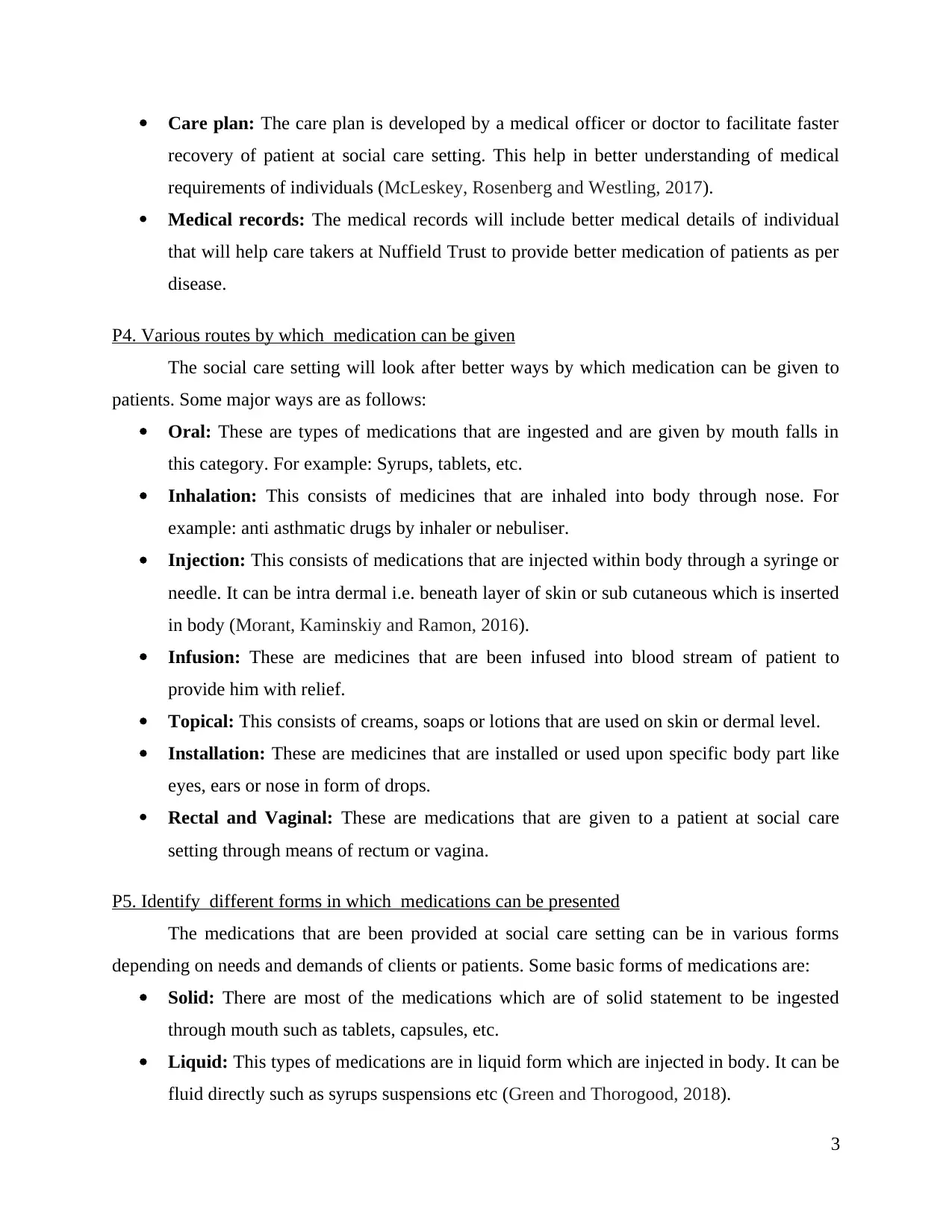
Care plan: The care plan is developed by a medical officer or doctor to facilitate faster
recovery of patient at social care setting. This help in better understanding of medical
requirements of individuals (McLeskey, Rosenberg and Westling, 2017).
Medical records: The medical records will include better medical details of individual
that will help care takers at Nuffield Trust to provide better medication of patients as per
disease.
P4. Various routes by which medication can be given
The social care setting will look after better ways by which medication can be given to
patients. Some major ways are as follows:
Oral: These are types of medications that are ingested and are given by mouth falls in
this category. For example: Syrups, tablets, etc.
Inhalation: This consists of medicines that are inhaled into body through nose. For
example: anti asthmatic drugs by inhaler or nebuliser.
Injection: This consists of medications that are injected within body through a syringe or
needle. It can be intra dermal i.e. beneath layer of skin or sub cutaneous which is inserted
in body (Morant, Kaminskiy and Ramon, 2016).
Infusion: These are medicines that are been infused into blood stream of patient to
provide him with relief.
Topical: This consists of creams, soaps or lotions that are used on skin or dermal level.
Installation: These are medicines that are installed or used upon specific body part like
eyes, ears or nose in form of drops.
Rectal and Vaginal: These are medications that are given to a patient at social care
setting through means of rectum or vagina.
P5. Identify different forms in which medications can be presented
The medications that are been provided at social care setting can be in various forms
depending on needs and demands of clients or patients. Some basic forms of medications are:
Solid: There are most of the medications which are of solid statement to be ingested
through mouth such as tablets, capsules, etc.
Liquid: This types of medications are in liquid form which are injected in body. It can be
fluid directly such as syrups suspensions etc (Green and Thorogood, 2018).
3
recovery of patient at social care setting. This help in better understanding of medical
requirements of individuals (McLeskey, Rosenberg and Westling, 2017).
Medical records: The medical records will include better medical details of individual
that will help care takers at Nuffield Trust to provide better medication of patients as per
disease.
P4. Various routes by which medication can be given
The social care setting will look after better ways by which medication can be given to
patients. Some major ways are as follows:
Oral: These are types of medications that are ingested and are given by mouth falls in
this category. For example: Syrups, tablets, etc.
Inhalation: This consists of medicines that are inhaled into body through nose. For
example: anti asthmatic drugs by inhaler or nebuliser.
Injection: This consists of medications that are injected within body through a syringe or
needle. It can be intra dermal i.e. beneath layer of skin or sub cutaneous which is inserted
in body (Morant, Kaminskiy and Ramon, 2016).
Infusion: These are medicines that are been infused into blood stream of patient to
provide him with relief.
Topical: This consists of creams, soaps or lotions that are used on skin or dermal level.
Installation: These are medicines that are installed or used upon specific body part like
eyes, ears or nose in form of drops.
Rectal and Vaginal: These are medications that are given to a patient at social care
setting through means of rectum or vagina.
P5. Identify different forms in which medications can be presented
The medications that are been provided at social care setting can be in various forms
depending on needs and demands of clients or patients. Some basic forms of medications are:
Solid: There are most of the medications which are of solid statement to be ingested
through mouth such as tablets, capsules, etc.
Liquid: This types of medications are in liquid form which are injected in body. It can be
fluid directly such as syrups suspensions etc (Green and Thorogood, 2018).
3
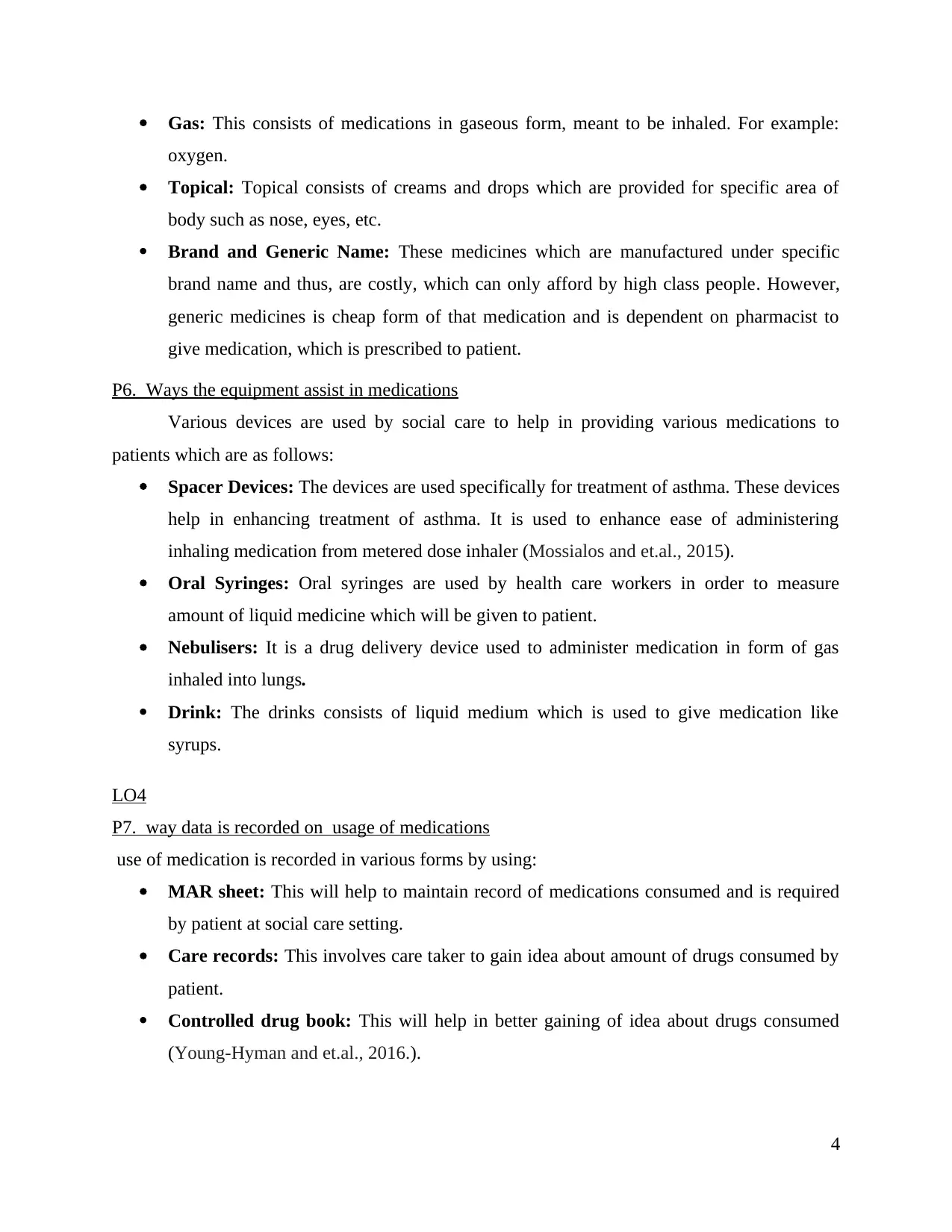
Gas: This consists of medications in gaseous form, meant to be inhaled. For example:
oxygen.
Topical: Topical consists of creams and drops which are provided for specific area of
body such as nose, eyes, etc.
Brand and Generic Name: These medicines which are manufactured under specific
brand name and thus, are costly, which can only afford by high class people. However,
generic medicines is cheap form of that medication and is dependent on pharmacist to
give medication, which is prescribed to patient.
P6. Ways the equipment assist in medications
Various devices are used by social care to help in providing various medications to
patients which are as follows:
Spacer Devices: The devices are used specifically for treatment of asthma. These devices
help in enhancing treatment of asthma. It is used to enhance ease of administering
inhaling medication from metered dose inhaler (Mossialos and et.al., 2015).
Oral Syringes: Oral syringes are used by health care workers in order to measure
amount of liquid medicine which will be given to patient.
Nebulisers: It is a drug delivery device used to administer medication in form of gas
inhaled into lungs.
Drink: The drinks consists of liquid medium which is used to give medication like
syrups.
LO4
P7. way data is recorded on usage of medications
use of medication is recorded in various forms by using:
MAR sheet: This will help to maintain record of medications consumed and is required
by patient at social care setting.
Care records: This involves care taker to gain idea about amount of drugs consumed by
patient.
Controlled drug book: This will help in better gaining of idea about drugs consumed
(Young-Hyman and et.al., 2016.).
4
oxygen.
Topical: Topical consists of creams and drops which are provided for specific area of
body such as nose, eyes, etc.
Brand and Generic Name: These medicines which are manufactured under specific
brand name and thus, are costly, which can only afford by high class people. However,
generic medicines is cheap form of that medication and is dependent on pharmacist to
give medication, which is prescribed to patient.
P6. Ways the equipment assist in medications
Various devices are used by social care to help in providing various medications to
patients which are as follows:
Spacer Devices: The devices are used specifically for treatment of asthma. These devices
help in enhancing treatment of asthma. It is used to enhance ease of administering
inhaling medication from metered dose inhaler (Mossialos and et.al., 2015).
Oral Syringes: Oral syringes are used by health care workers in order to measure
amount of liquid medicine which will be given to patient.
Nebulisers: It is a drug delivery device used to administer medication in form of gas
inhaled into lungs.
Drink: The drinks consists of liquid medium which is used to give medication like
syrups.
LO4
P7. way data is recorded on usage of medications
use of medication is recorded in various forms by using:
MAR sheet: This will help to maintain record of medications consumed and is required
by patient at social care setting.
Care records: This involves care taker to gain idea about amount of drugs consumed by
patient.
Controlled drug book: This will help in better gaining of idea about drugs consumed
(Young-Hyman and et.al., 2016.).
4
⊘ This is a preview!⊘
Do you want full access?
Subscribe today to unlock all pages.

Trusted by 1+ million students worldwide
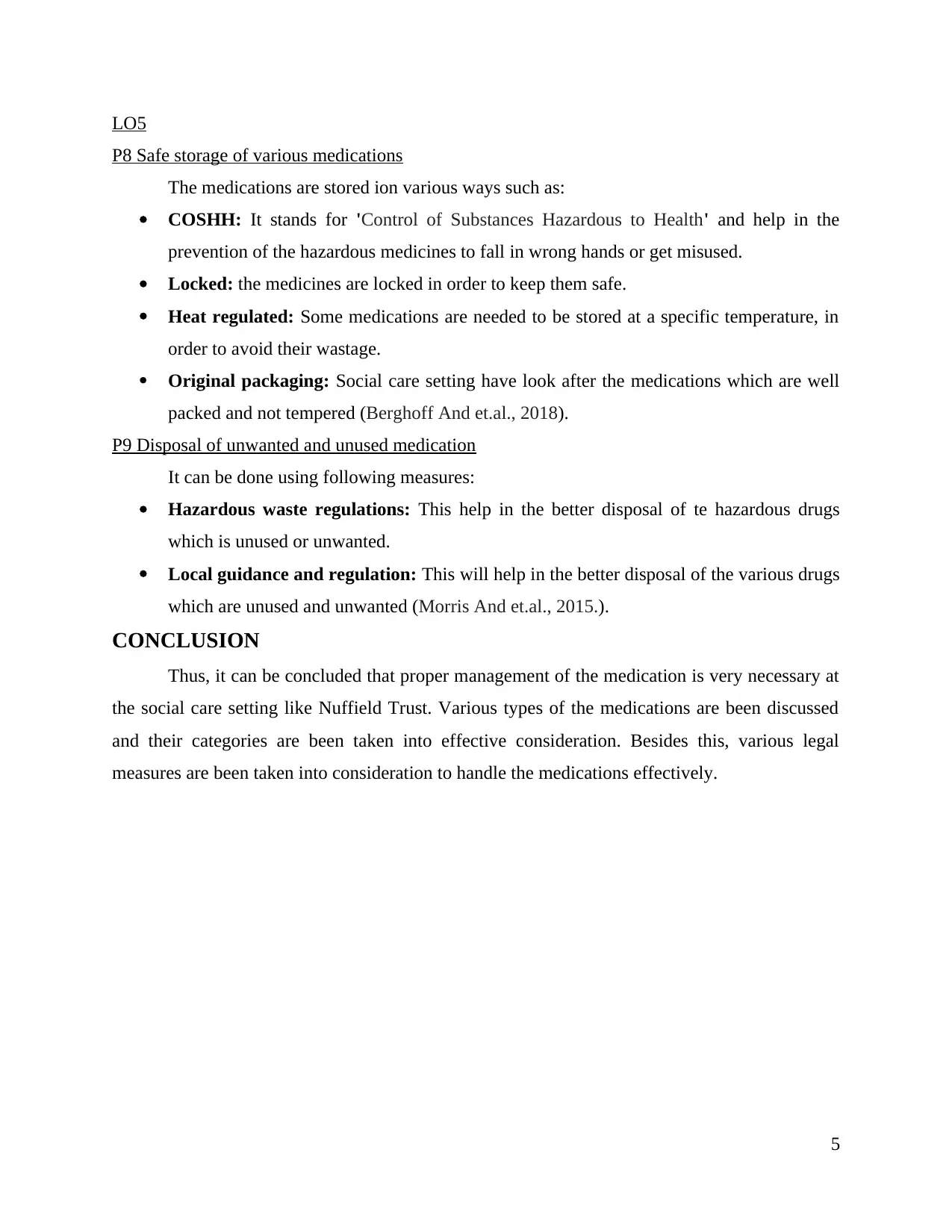
LO5
P8 Safe storage of various medications
The medications are stored ion various ways such as:
COSHH: It stands for 'Control of Substances Hazardous to Health' and help in the
prevention of the hazardous medicines to fall in wrong hands or get misused.
Locked: the medicines are locked in order to keep them safe.
Heat regulated: Some medications are needed to be stored at a specific temperature, in
order to avoid their wastage.
Original packaging: Social care setting have look after the medications which are well
packed and not tempered (Berghoff And et.al., 2018).
P9 Disposal of unwanted and unused medication
It can be done using following measures:
Hazardous waste regulations: This help in the better disposal of te hazardous drugs
which is unused or unwanted.
Local guidance and regulation: This will help in the better disposal of the various drugs
which are unused and unwanted (Morris And et.al., 2015.).
CONCLUSION
Thus, it can be concluded that proper management of the medication is very necessary at
the social care setting like Nuffield Trust. Various types of the medications are been discussed
and their categories are been taken into effective consideration. Besides this, various legal
measures are been taken into consideration to handle the medications effectively.
5
P8 Safe storage of various medications
The medications are stored ion various ways such as:
COSHH: It stands for 'Control of Substances Hazardous to Health' and help in the
prevention of the hazardous medicines to fall in wrong hands or get misused.
Locked: the medicines are locked in order to keep them safe.
Heat regulated: Some medications are needed to be stored at a specific temperature, in
order to avoid their wastage.
Original packaging: Social care setting have look after the medications which are well
packed and not tempered (Berghoff And et.al., 2018).
P9 Disposal of unwanted and unused medication
It can be done using following measures:
Hazardous waste regulations: This help in the better disposal of te hazardous drugs
which is unused or unwanted.
Local guidance and regulation: This will help in the better disposal of the various drugs
which are unused and unwanted (Morris And et.al., 2015.).
CONCLUSION
Thus, it can be concluded that proper management of the medication is very necessary at
the social care setting like Nuffield Trust. Various types of the medications are been discussed
and their categories are been taken into effective consideration. Besides this, various legal
measures are been taken into consideration to handle the medications effectively.
5
Paraphrase This Document
Need a fresh take? Get an instant paraphrase of this document with our AI Paraphraser
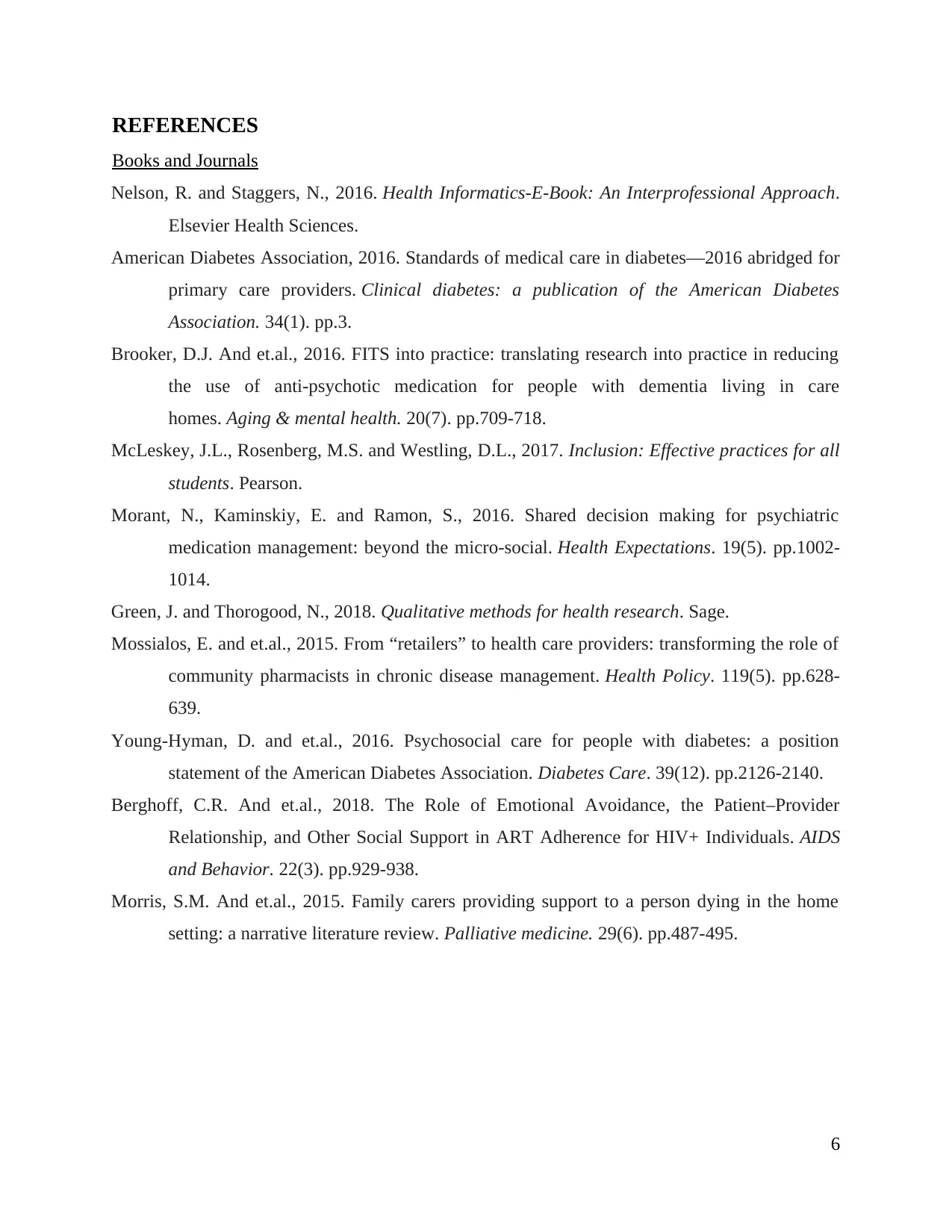
REFERENCES
Books and Journals
Nelson, R. and Staggers, N., 2016. Health Informatics-E-Book: An Interprofessional Approach.
Elsevier Health Sciences.
American Diabetes Association, 2016. Standards of medical care in diabetes—2016 abridged for
primary care providers. Clinical diabetes: a publication of the American Diabetes
Association. 34(1). pp.3.
Brooker, D.J. And et.al., 2016. FITS into practice: translating research into practice in reducing
the use of anti-psychotic medication for people with dementia living in care
homes. Aging & mental health. 20(7). pp.709-718.
McLeskey, J.L., Rosenberg, M.S. and Westling, D.L., 2017. Inclusion: Effective practices for all
students. Pearson.
Morant, N., Kaminskiy, E. and Ramon, S., 2016. Shared decision making for psychiatric
medication management: beyond the micro‐social. Health Expectations. 19(5). pp.1002-
1014.
Green, J. and Thorogood, N., 2018. Qualitative methods for health research. Sage.
Mossialos, E. and et.al., 2015. From “retailers” to health care providers: transforming the role of
community pharmacists in chronic disease management. Health Policy. 119(5). pp.628-
639.
Young-Hyman, D. and et.al., 2016. Psychosocial care for people with diabetes: a position
statement of the American Diabetes Association. Diabetes Care. 39(12). pp.2126-2140.
Berghoff, C.R. And et.al., 2018. The Role of Emotional Avoidance, the Patient–Provider
Relationship, and Other Social Support in ART Adherence for HIV+ Individuals. AIDS
and Behavior. 22(3). pp.929-938.
Morris, S.M. And et.al., 2015. Family carers providing support to a person dying in the home
setting: a narrative literature review. Palliative medicine. 29(6). pp.487-495.
6
Books and Journals
Nelson, R. and Staggers, N., 2016. Health Informatics-E-Book: An Interprofessional Approach.
Elsevier Health Sciences.
American Diabetes Association, 2016. Standards of medical care in diabetes—2016 abridged for
primary care providers. Clinical diabetes: a publication of the American Diabetes
Association. 34(1). pp.3.
Brooker, D.J. And et.al., 2016. FITS into practice: translating research into practice in reducing
the use of anti-psychotic medication for people with dementia living in care
homes. Aging & mental health. 20(7). pp.709-718.
McLeskey, J.L., Rosenberg, M.S. and Westling, D.L., 2017. Inclusion: Effective practices for all
students. Pearson.
Morant, N., Kaminskiy, E. and Ramon, S., 2016. Shared decision making for psychiatric
medication management: beyond the micro‐social. Health Expectations. 19(5). pp.1002-
1014.
Green, J. and Thorogood, N., 2018. Qualitative methods for health research. Sage.
Mossialos, E. and et.al., 2015. From “retailers” to health care providers: transforming the role of
community pharmacists in chronic disease management. Health Policy. 119(5). pp.628-
639.
Young-Hyman, D. and et.al., 2016. Psychosocial care for people with diabetes: a position
statement of the American Diabetes Association. Diabetes Care. 39(12). pp.2126-2140.
Berghoff, C.R. And et.al., 2018. The Role of Emotional Avoidance, the Patient–Provider
Relationship, and Other Social Support in ART Adherence for HIV+ Individuals. AIDS
and Behavior. 22(3). pp.929-938.
Morris, S.M. And et.al., 2015. Family carers providing support to a person dying in the home
setting: a narrative literature review. Palliative medicine. 29(6). pp.487-495.
6
1 out of 8
Related Documents
Your All-in-One AI-Powered Toolkit for Academic Success.
+13062052269
info@desklib.com
Available 24*7 on WhatsApp / Email
![[object Object]](/_next/static/media/star-bottom.7253800d.svg)
Unlock your academic potential
Copyright © 2020–2025 A2Z Services. All Rights Reserved. Developed and managed by ZUCOL.





